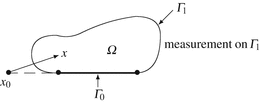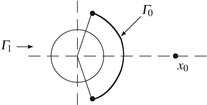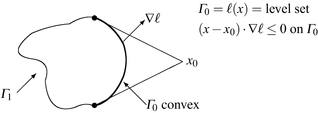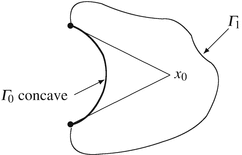Abstract
We consider an inverse problem for the linearized Jordan–Moore–Gibson–Thompson equation, which is a third-order (in time) PDE in the original unknown u that arises in nonlinear acoustic waves modeling high-intensity ultrasound. Both canonical recovery problems are investigated: (i) uniqueness and (ii) stability, by use of just one boundary measurement. Our approach relies on the dynamical decomposition of the Jordan–Moore–Gibson–Thompson equation given in Marchand et al. (Math. Methods Appl. Sci. 35, 1896–1929, 2012), which identified 3 distinct models in the new variable z. By using now z-model ♯3, we weaken by two units the regularity requirements on the data of the original u-dynamics over our prior effort Liu and Triggiani (J. Inverse Ill-Posed Probl. 21, 825–869, 2013), which instead employed z-model ♯1.
In memory of Alfredo Lorenzi: scholar, collaborator, friend
This is a preview of subscription content, log in via an institution.
Buying options
Tax calculation will be finalised at checkout
Purchases are for personal use only
Learn about institutional subscriptionsReferences
Beilina, L., Klibanov, M.: Approximate Global Convergence and Adaptivity for Coefficient Inverse Problems. Springer, New York (2012)
Bukhgeim, A., Cheng, J., Isakov. V., Yamamoto, M.: Uniqueness in determining damping coefficients in hyperbolic equations. In: Saburou Saitoh, Nakao Hayashi, Masahiro Yamamoto (eds.), Analytic Extension Formulas and Their Applications, pp. 27–46. Kluwer, Dordrecht (2001)
Bukhgeim, A., Klibanov, M.: Global uniqueness of a class of multidimensional inverse problem. Sov. Math. Dokl. 24, 244–257 (1981)
Carleman, T.: Sur un problème d’unicité pour les systèmes d’équations aux derivées partielles à deux variables independantes. Ark. Mat. Astr. Fys.2B, 1–9 (1939)
Ho, L. F.: Observabilite frontiere de l’equation des ondes. Comptes Rendus de l’Academie des Sciences de Paris 302, 443–446 (1986)
Hörmander, L.: The Analysis of Linear Partial Differential Operators I. Springer, Berlin/ New York (1985)
Hörmander, L.: The Analysis of Linear Partial Differential Operators II. Springer, Berlin/ New York (1985)
Isakov, V.: Inverse Problems for Partial Differential Equations, 1st edn. Springer, New York (1998)
Isakov, V.: Inverse Problems for Partial Differential Equations, 2nd edn. Springer, New York (2006)
Isakov, V., Yamamoto, M.: Carleman estimate with the Neumann boundary condition and its application to the observability inequality and inverse hyperbolic problems. Contemp. Math. 268, 191–225 (2000)
Isakov, V., Yamamoto, M.: Stability in a wave source problem by Dirichlet data on subboundary. J. Inverse Ill-Posed Probl. 11, 399–409 (2003)
Jordan, P.M.: An analytic study of the Kuznetsov’s equation: diffusive solitons, shock formation, and solution bifurcation. Phys. Lett. A 326, 77–84 (2004)
Jordan, P.M.: Nonlinear acoustic phenomena in viscous thermally relaxing fluids: shock bifurcation and the emergence of diffusive solitions (A) (Lecture). The 9th International Conference on Theoretical and Computational Acoustics (ICTCA 2009), Dresden, Germany. J. Acoust. Soc. Am. 124, 2491–2491 (2008)
Kaltenbacher, B., Lasiecka, I.: Global existence and exponential decay rates for the Westervelt equation. DCDS Ser. S 2, 503–525 (2009)
Kaltenbacher, B., Lasiecka, I.: Well-posedness of the Westervelt and the Kuznetsov equations with non homogeneous Neumann boundary conditions. DCDS Suppl., 763–773 (2011)
Kaltenbacher, B., Lasiecka, I., Marchand, R.: Wellposedness and exponential decay rates for the Moore–Gibson–Thompson equation arising in high intensity ultrasound. Control Cybern. (2011)
Kaltenbacher, B., Lasiecka, I., Veljovic, S.: Well-posedness and exponential decay of the Westervelt equation with inhomogeneous Dirichlet boundary data. Progress in Nonlinear Differential Equations and Their Applications, vol. 60. Springer, Basel (2011)
Klibanov, M.: Inverse problems and Carleman estimates. Inverse Probl. 8, 575–596 (1992)
Klibanov, M.: Carleman estimates for global uniqueness, stability and numerical methods for coefficient inverse problems. J. Inverse Ill-Posed Probl. 21(2), (2013)
Klibanov, M., Timonov, A.: Carleman Estimates for Coefficient Inverse Problems and Numerical Applications. VSP, Utrecht (2004)
Kuznetsov, V.P.: Equations of nonlinear acoustics. Sov. Phys. 16, 467–470 (1971)
Lasiecka, I., Lions, J.L., Triggiani, R.: Non-homogeneous boundary value problems for second-order hyperbolic operators. J. Math. Pures Appl. 65, 149–192 (1986)
Lasiecka, I., Triggiani, R.: A cosine operator approach to modeling L 2(0, T; L 2(Ω)) boundary input hyperbolic equations. Appl. Math. Optim. 7, 35–83 (1981)
Lasiecka, I., Triggiani, R.: Regularity of hyperbolic equations under L 2(0, T; L 2(Γ))-Dirichlet boundary terms. Appl. Math. Optim. 10, 275–286 (1983)
Lasiecka, I., Triggiani, R.: Exact controllability of the wave equation with Neumann boundary control. Appl. Math. Optim. 19, 243–290 (1989)
Lasiecka, I., Triggiani, R.: Sharp regularity theory for second-order hyperbolic equations of Neumann type Part I: L 2 non-homogeneous data. Ann. Mat. Pura Appl. (IV) CLVII, 285–367 (1990)
Lasiecka, I., Triggiani, R.: Regularity theory of hyperbolic equations with non-homogeneous Neumann boundary conditions II: General boundary data. J. Differ. Equ. 94, 112–164 (1991)
Lasiecka, I., Triggiani, R.: Recent advances in regularity of second-order hyperbolic mixed problems and applications. Dynamics Reported, vol. 3, pp. 104–158. Springer, New York (1994)
Lasiecka, I., Triggiani, R.: Carleman estimates and uniqueness for the system of strong coupled PDE’s of spherical shells. Special volume of Zeits. Angerwandte Math. Mech. vol. 76, pp.277–280. Akademie, Berlin (1996)
Lasiecka, I., Triggiani, R.: Carleman estimates and exact controllability for a system of coupled, nonconservative second-order hyperbolic equations. Lect. Notes Pure Appl. Math. 188, 215–245 (1997)
Lasiecka, I., Triggiani, R.: Exact boundary controllability of a first-order nonlinear hyperbolic equation with non-local in the integral term arising in epidemic modeling. In: Gilbert, R.P., Kajiwara, J., Xu, Y. (eds.) Direct and Inverse Problems of Mathematical Physics, pp. 363–398. ISAAC’97, The First International Congress of the International Society for Analysis, Its Applications and Computations. Kluwer (2000)
Lasiecka, I., Triggiani, R.: Uniform stabilization of the wave equation with Dirichlet or Neumann-feedback control without geometrical conditions. Appl. Math. Optim. 25, 189–224 (1992)
Lasiecka, I., Triggiani, R., Yao, P.F.: Exact controllability for second-order hyperbolic equations with variable coefficient-principal part and first-order terms. Nonlinear Anal. 30(1), 111–222 (1997)
Lasiecka, I., Triggiani, R., Yao, P.F.: Inverse/observability estimates for second-order hyperbolic equations with variable coefficients. J. Math. Anal. Appl. 235(1), 13–57 (1999)
Lasiecka, I., Triggiani, R., Zhang, X.: Nonconservative wave equations with unobserved Neumann B.C.: Global uniqueness and observability in one shot. Contemp. Math. 268, 227–325 (2000)
Lavrentev, M.M., Romanov, V.G., Shishataskii, S.P.: Ill-Posed Problems of Mathematical Physics and Analysis, vol. 64. The American Mathematical Society, Providence (1986)
Lions, J.L.: Controlabilite Exacte, Perturbations et Stabilisation de Systemes Distribues, vol. 1. Masson, Paris (1988)
Liu, S.: Inverse problem for a structural acoustic interaction. Nonlinear Anal. 74, 2647–2662 (2011)
Liu, S., Triggiani, R.: Global uniqueness and stability in determining the damping and potential coefficients of an inverse hyperbolic problem. Nonlinear Anal. Real World Appl. 12, 1562–1590 (2011)
Liu, S., Triggiani, R.: Global uniqueness and stability in determining the damping coefficient of an inverse hyperbolic problem with non-homogeneous Neumann B.C. through an additional Dirichlet boundary trace. SIAM J. Math. Anal. 43, 1631–1666 (2011)
Liu, S., Triggiani, R.: Global uniqueness in determining electric potentials for a system of strongly coupled Schrödinger equations with magnetic potential terms. J. Inverse Ill-Posed Probl. 19, 223–254 (2011)
Liu, S., Triggiani, R.: Recovering the damping coefficients for a system of coupled wave equations with Neumann BC: uniqueness and stability. Chin. Ann. Math. Ser. B 32, 669–698 (2011)
Liu, S., Triggiani, R.: Determining damping and potential coefficients of an inverse problem for a system of two coupled hyperbolic equations. Part I: global uniqueness. DCDS Supplement, 1001–1014 (2011)
Liu, S., Triggiani, R.: Global uniqueness and stability in determining the damping coefficient of an inverse hyperbolic problem with non-homogeneous Dirichlet B.C. through an additional localized Neumann boundary trace. Appl. Anal.91(8), 1551–1581 (2012)
Liu, S., Triggiani, R.: Recovering damping and potential coefficients for an inverse non-homogeneous second-order hyperbolic problem via a localized Neumann boundary trace. Discrete Contin. Dyn. Syst. Ser. A 33(11–12), 5217–5252 (2013)
Liu, S., Triggiani, R.: Boundary control and boundary inverse theory for non-homogeneous second-order hyperbolic equations: a common Carleman estimates approach. HCDTE Lecture notes, AIMS Book Series on Applied Mathematics, vol. 6, pp. 227–343 (2013)
Liu, S., Triggiani, R.: An inverse problem for a third order PDE arising in high-intensity ultrasound: global uniqueness and stability by one boundary measurement. J. Inverse Ill-Posed Probl. 21, 825–869 (2013)
Marchand, R., McDevitt, T., R. Triggiani, R.: An abstract semigroup approach to the third-order Moore-Gibson-Thompson partial differential equation arising in high-intensity ultrasound: structural decomposition, spectral analysis, exponential stability. Math. Methods Appl. Sci. 35, 1896–1929 (2012)
Mazya, V.G., Shaposhnikova, T.O.: Theory of Multipliers in Spaces of Differentiable Functions, vol. 23. Monographs and Studies in Mathematics, Pitman (1985)
Pazy, A.: Semigroups of linear operators and applications to partial differential equations. Applied Mathematical Sciences, vol. 44. Springer, New York (1983)
Tataru, D.: A-priori estimates of Carleman’s type in domains with boundary. J. Math. Pures. et Appl. 73, 355–387 (1994)
Tataru, D.: Boundary controllability for conservative PDE’s. Appl. Math. & Optimiz. 31, 257–295 (1995); Based on a Ph.D. dissertation, University of Virginia (1992)
Tataru, D.: Carleman estimates and unique continuation for solutions to boundary value problems. J. Math. Pures Appl. 75, 367–408 (1996)
Tataru, D.: On the regularity of boundary traces for the wave equation. Ann. Scuola Norm. Sup. Pisa Cl. Sci. (4) 26, 185–206 (1998)
Taylor, M.: Pseudodifferential Operators. Princeton University Press, Princeton (1981)
Triggiani, R.: Exact boundary controllability of L 2(Ω) × H −1(Ω) of the wave equation with Dirichlet boundary control acting on a portion of the boundary and related problems. Appl. Math. Optim. 18(3), 241–277 (1988)
Triggiani, R.: Wave equation on a bounded domain with boundary dissipation: an operator approach. J. Math. Anal. Appl. 137, 438–461 (1989)
Triggiani, R., Yao, P.F.: Carleman estimates with no lower order terms for general Riemannian wave equations: global uniqueness and observability in one shot. Appl. Math. Optim. 46, 331–375 (2002)
Yamamoto, M.: Uniqueness and stability in multidimensional hyperbolic inverse problems. J. Math. Pures Appl. 78, 65–98 (1999)
Acknowledgements
The authors wish to thank a referee for suggesting to extend their original version to include the global uniqueness of Theorem 15.5 of any damping coefficient. S.L. was supported by a startup grant from Clemson University and R.T. was supported by the National Science Foundation under Grant DMS-0104305 and by the Air Force Office of Scientific Research under Grant FA9550-09-1-0459.
Author information
Authors and Affiliations
Corresponding author
Editor information
Editors and Affiliations
Appendices
Appendix 1: Admissible Geometrical Configurations in the Neumann B.C. Case
Here we present some examples in connection to the main geometrical assumptions (A.1), (A.2). We refer to Lasiecka et al. [35] for more details.
- Example #1 :
-
(Any dimension ≥ 2): Γ 0 is flat.

Let x 0 ∈ hyperplane containing Γ 0, then.
$$\displaystyle{d(x) =\| x - x_{0}\|^{2};\quad h(x) = \nabla d(x) = 2(x - x_{ 0}).}$$ - Example #2 :
-
(A ball of any dimension ≥ 2): d(x) in [35, Theorem. A.4.1, p. 301].
 Measurement on \(\varGamma _{1}> \frac{1} {2}\) circumference (as in the Dirichlet case), same as for controllability.
Measurement on \(\varGamma _{1}> \frac{1} {2}\) circumference (as in the Dirichlet case), same as for controllability. - Example #3 :
-
(Generalizing Ex #2: a domain Ω of any dimension ≥ 2 with unobserved portion Γ 0 convex, subtended by a common point x 0): d(x) in [35, Theorem. A.4.1, p. 301].

- Example #4 :
-
(A domain Ω of any dimension ≥ 2 with unobserved portion Γ 0 concave, subtended by a common point x 0): d(x) in [35, Theorem. A.4.1, p. 301].

- Example #5 :
-
(dim = 2): Γ 0 neither convex nor concave. Γ 0 is described by graph
$$\displaystyle{y = \left \{\begin{array}{ll} f_{1}(x),x_{0} \leq x \leq x_{1},&y \geq 0; \\ f_{2}(x),x_{2} \leq x \leq x_{1},&y <0,\end{array} \right.}$$f 1, f 2 logarithmic concave on x 0 < x < x 1, e.g., sinx, \(-\frac{\pi }{2} <x <\frac{\pi } {2}\); cosx, 0 < x < π
 as the function sinx + 1 and cosx + 1 are lobarithmic concave on the corresponding x-intervals. See [35, Fig. A.3, p. 290]. The corresponding function d(x) is given in [35, (A.2.7), p. 289].
as the function sinx + 1 and cosx + 1 are lobarithmic concave on the corresponding x-intervals. See [35, Fig. A.3, p. 290]. The corresponding function d(x) is given in [35, (A.2.7), p. 289].
Appendix 2: Sharp Regularity Theory for Second-Order Hyperbolic Equations of Neumann Type
Consider the following second-order hyperbolic equation with non-homogeneous Neumann B.C g and I.C. {w 0, w 1}:
where the forcing term
and F(w) is given by
subject to the following standing assumption on the coefficients: q 1, q 2, | q 3 | ∈ L ∞(Q), so that the following pointwise estimate holds true:
We first define the parameters α and β to be the following values:
where ε > 0 is arbitrary. Then we have the following sharp regularity results:
Theorem ([27, Theorem 1.2 (ii), (iii), 1.3, p. 290])
With reference to the above w-mixed problem, the following regularity results hold true, with α and β defined above:
-
(i) [27, Theorem 2.0, (15.21), ( 2.9 ), p. 123; Theorem A, p. 117; Theorem 2.1, p. 124]. Suppose we have f = 0, {w 0 ,w 1 } ∈ H 1 (Ω) × L 2 (Ω) and g ∈ L 2 (Σ). Then we have the unique solution w satisfies
$$\displaystyle{ w \in H^{\alpha }(Q) = C([0,T];H^{\alpha }(\varOmega )) \cap H^{\alpha }(0,T;L^{2}(\varOmega ));\quad w\vert _{\varSigma }\in H^{2\alpha -1}(\varSigma ). }$$ -
(ii) [27, Theorem 5.1 , (5.4), (5.5), p. 149; Theorem C, p. 118; Theorem 7.1, p. 158]. Suppose now f ∈ L 2 (Q), {w 0 ,w 1 } ∈ H 1 (Ω) × L 2 (Ω) and g = 0. Then we have
$$\displaystyle{ w \in C([0,T];H^{1}(\varOmega )),\ w_{ t} \in C([0,T];L^{2}(\varOmega ));\quad w\vert _{\varSigma }\in H^{\beta }(\varSigma ). }$$
Rights and permissions
Copyright information
© 2014 Springer International Publishing Switzerland
About this chapter
Cite this chapter
Liu, S., Triggiani, R. (2014). Inverse Problem for a Linearized Jordan–Moore–Gibson–Thompson Equation. In: Favini, A., Fragnelli, G., Mininni, R. (eds) New Prospects in Direct, Inverse and Control Problems for Evolution Equations. Springer INdAM Series, vol 10. Springer, Cham. https://doi.org/10.1007/978-3-319-11406-4_15
Download citation
DOI: https://doi.org/10.1007/978-3-319-11406-4_15
Published:
Publisher Name: Springer, Cham
Print ISBN: 978-3-319-11405-7
Online ISBN: 978-3-319-11406-4
eBook Packages: Mathematics and StatisticsMathematics and Statistics (R0)



 Measurement on
Measurement on 

 as the function sinx + 1 and cosx + 1 are lobarithmic concave on the corresponding x-intervals. See [
as the function sinx + 1 and cosx + 1 are lobarithmic concave on the corresponding x-intervals. See [